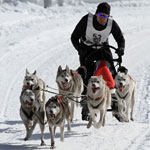Sled Dog Day Date in the current year: February 2, 2025
 Sled Dog Day, sometimes referred to as National Sled Dog Day, celebrates loyal and hard-working animals that used to be the only means of transportation in the Arctic region. It is observed on February 2 to commemorate the famous 1925 serum run to Nome, which saved the Alaskan town of Nome from a diphtheria epidemic.
Sled Dog Day, sometimes referred to as National Sled Dog Day, celebrates loyal and hard-working animals that used to be the only means of transportation in the Arctic region. It is observed on February 2 to commemorate the famous 1925 serum run to Nome, which saved the Alaskan town of Nome from a diphtheria epidemic.Sled dogs are dogs trained and used to pull a sled or another land vehicle over snow in harness. They have been used in the Arctic region, which includes Alaska, Canada, the Chukchi Peninsula, Greenland, Finland, Norway, Siberia and Sweden, for millennia.
Originally, sled dogs were bred for their size, strength and stamina. Modern sled dog breeds are bred for their speed and endurance, since they are primarily used in sled dog racing rather than for transportation.
Arguably the most popular sled dog breeds are the Siberian Husky, the Alaskan Malamute, and the Samoyed Dog. Other popular breeds include the Alaskan Husky, the Canadian Inuit Dog, the Chinook, the Greenland Dog, the Labrador Husky, the Mackenzie River Husky, the Sakhalin Husky, and the Yakutian Laika.
Sled dogs were the only means of transportation in remote inland areas of the Arctic until the introduction of airplanes, snowmobiles and semi-trailer trucks in the first half of the 20th century. They delivered supplies and mail to areas inaccessible by other methods. Sled dogs played a role in the Klondike Gold Rush and the exploration of both poles.
The most famous use of sled dogs as a means of transportation was the 1925 serum run to Nome, also known as the Great Race of Mercy. In the 1924–1925, there was an outbreak of diphtheria in the remote Alaskan town of Nome. If untreated, the disease could wipe out the entire town. The closest available supply of diphtheria antitoxin was found in Anchorage.
The antitoxin was transported to Nenana by railway, but the only way to transport it from Nenana to Nome was by sled dogs. 150 sled dogs and 20 mushers transported the antitoxin across 1,085 km in five and a half days in a relay fashion. Balto, the dog that led the team on the final stretch of the run, became one of the world’s most famous dogs, but the “unsung hero” of the Great Race of Mercy was Togo, whose team covered the longest and one of the most dangerous parts of the route.
The antitoxin arrived in Nome around 5:30 AM on February 2, 1925. The next day, the epidemic was under control. To commemorate the successful finish of the Great Race of Mercy, its anniversary is now observed as Sled Dog Day, although it is unclear when it was first celebrated and who came up with the idea of the celebration.
Today sled dogs are only occasionally used as a means of transportation, mainly by some remote rural communities in Alaska, Canada and Russia as well as much of Greenland. However, they are still used for racing events and recreational purposes. The most famous sled dog race is the Iditarod Trail Sled Dog Race that runs from Anchorage to Nome to commemorate the 1925 serum run. It was inaugurated in 1973.
- Category
- Other Observances
- Tags
- Sled Dog Day, National Sled Dog Day, sled dogs, 1925 serum run to Nome, Great Race of Mercy